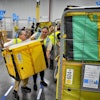
 Mick Arnold
Mick ArnoldEstimates show that there are 600,000 unfilled manufacturing jobs in the United States. This number could reach two million by 2025. Despite these facts, our society pushes students toward higher education, regardless of a student’s interests or aptitude. Along the way, manufacturers are losing an opportunity to attract high school seniors and recent graduates into fields where jobs are plentiful and appropriately suited for these students.
So how can we attract students to manufacturing jobs for skilled workers? And how do we appeal to parents, teachers and guidance counselors? Let’s take a three-pronged approach.
No. 1 - Combat the Misperceptions
Dirty, dingy and dangerous. It’s a long-lived perception. How many students are given the opportunity to tour a manufacturing facility? Modern manufacturing plants look more like labs than factories, with sophisticated technology like robotics, additive manufacturing and computer-integration. Let’s invite students into our facilities to see what these work environments are really like.
Salaries are low and opportunities for career growth are limited. Skilled laborers are in such demand that they can quickly approach six figures, but are we telling this to parents and teachers? New hires often get signing bonuses and then competitive raises. When manufacturers find the right person, they aren’t going to let them go. They provide them with training and education to progress in their careers. We need to share this information with school guidance counselors.
The only path to success is college. That’s what our country has been telling kids for 70 years. The number of colleges and universities in the U.S. grew by 60 percent between 1950 and 2014. During that same time period, the number of college students jumped from 2.4 million to 20.2 million. The conflict in changing this “college is a must” perception is that high schools are rated on what percentage of their students go onto college, not whether these students get jobs or go on to have a successful career after a four-year college education. Let’s teach schools, students and parents to think twice about college acceptance as the defining metric of success.
Apprenticeships are a thing of the past. This is partially true, but changing. The Department of Labor reported in 2017 that the number of apprenticeships grew from 400,000 to 500,000 in the four years prior. Yet, looking at the big picture, that is still fewer than two percent of 18- to 24-year-olds. There is a huge opportunity for manufacturers to draw young people in. Show students and parents that you have designed a well-defined route from learning to earning. Plus, tell them this: A White House report in 2014 said that 91 percent of apprentices find employment after completing their programs, with an average starting salary of more than $51,000. In some cases, companies have replaced apprenticeships with internships, but internships are risky for employers. If the interns are in high school, you can put hours and hours into training and then they move on to college. With college interns, you have to compel them not to return to their home states. It is time to bring back the formal apprenticeship.
No. 2 - Communicate Our Needs
It’s nearly impossible to believe that manufacturers are still hosting in-person job fairs. Where is the eHarmony for manufacturing? How do we connect supply and demand without the use of head hunters, staffing agencies and other expensive, unreliable sources? One of the biggest problems is that there is a lack of communication between what manufacturing employers are looking for and what is being delivered in the high-school curriculum. Careers in manufacturing aren’t at the forefront of the minds of parents and teachers, so they aren’t considering the skills that would make a recent graduate valuable in the skilled labor trades. That includes:
- Solid math skills
- Mastery of measuring devices like scales, tape measures and measurement conversions
- Mechanical experience
- Cognitive reasoning
- The “figure-it-out” factor
Next, there are concentrations of study that high schools or city-wide school systems could offer that could lead to positions in manufacturing:
- Coding
- Machining
- Electrical
- CAD Drawing
- Fabrication
- Engineering design
What we need to do, as manufacturers, is to engage high schools aggressively by sharing our needs. The goal is to offer exposure early. Ideally, manufacturing skills would find their way into the curriculum again. Then teachers could recognize a particular aptitude and desire.
No. 3 - Connect with the Community
The Social Security Administration reports that 10,000 baby boomers per day are leaving the workplace. Combine that with the fact that the average age of skilled workers is 56, and it’s clear it is time for manufacturers to get aggressive — and creative.
There are opportunities to connect with young people before they leave high school. Some are national and others highly local. For example, SkillsUSA serves high school and college students who are enrolled in technical, skilled and service occupations. Along with skilled labor training, the program incorporates formal instruction in workplace skills (like communication and decision making) and personal skills (like work ethic and self-motivation).
Reach out to high schools in your region that are specifically structured for skilled learning. You may find students eager to enter the workforce immediately after graduation. For example, the Applications and Research Laboratory is part of the public school system in Howard County, Maryland, which offers courses in fabrication, mechanics, engineering design and electronics.
Look to high school clubs and organizations and talk with their academic sponsors or coaches. Perfect examples include students in their school-based engineering and STEM clubs, students participating in internationally known organizations like FIRST Robotics or Hack Club and students in national competitions like Junior Solar Sprint or TEAMS (Tests of Engineering Aptitude, Mathematics and Science). Search for these clubs online for locations near your facility.
What’s Next?
There are students out there who would thrive in manufacturing, but the industry needs to go after them (and their influencers) proactively. Start with any one of the steps above and see where it takes you. The responsibility for preparing the manufacturing workforce of the future is ours.
Mick Arnold is president and fourth-generation owner of Arnold Packaging.























